Boot: 2021-2022 Atomic Hawx Prime XTD 130 Tech
Test Duration: ~35 days
Test Locations: Crested Butte & Mt. Sneffels, Colorado
Stated Flex: 130
Available Sizes: 22–32.5
Stated Last (size 26.5): 100 mm (heat moldable)
Stated Range of Motion: 54°
Stated Forward Lean: 15° stock (can be adjusted to 13° and 17°)
Size Tested: 26.5
Stated Boot Sole Length: 305 mm
Blister’s Measured Weight (size 26.5):
- Shells, no Liners: 1242 & 1249 g
- Liners, no Footbeds: 408 & 410 g
- Shells + Liners = 1650 & 1659 g
Buckles: 4 micro-adjustable 6000-series aluminum
Powerstrap: 50 mm cam-style
Shell Material:
- Cuff: Grilamid
- Shoe / Clog: Grilamid
Soles: GripWalk
Tech Fittings: yes
Binding Compatibility: GripWalk-compatible bindings; tech / pin bindings
Reviewer: 5’8″, 155 lbs / 173 cm, 70.3 kg
Skis / Bindings Used:
- Majesty Superwolf + Majesty / ATK R12
- Folsom Cash 106 Carbon + Dynafit Radical 2.0 FT
- J Skis Slacker + Marker Kingpin
- Movement Alp Tracks 106 + Marker Kingpin
- Majesty Vanguard + Fritschi Tecton
- Volkl Revolt 104 + Marker Griffon
- J Skis Hotshot + Marker Griffon
- Faction Agent 3.0 + Marker Kingpin
- Sego Condor 108 + Armada Shift 13
- Black Crows Justis + Tyrolia AAAttack2 13 AT
- Volkl Blaze 106 + Marker Duke PT 16
- K2 Reckoner 102 + Tyrolia AAAttack2 13 AT
[Note: our review was conducted on the 20/21 Hawx Prime XTD 130, which was not changed for 21/22.]
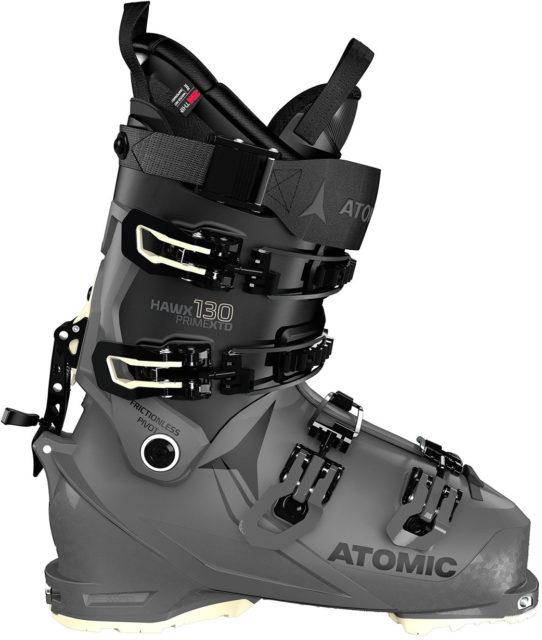
Intro
A few months ago we talked with Atomic’s product manager of ski boots, Matt Manser, about a ton of things, including the new Atomic Hawx Prime XTD boots. You should definitely check out that conversation and our other conversations with Matt Manser for some really detailed info on ski boots, but here we’re taking a closer look at the new Hawx Prime XTD 130.
We’ve been really impressed by Atomic’s Hawx Ultra XTD boots’ blend of uphill and downhill performance, with those boots receiving our “Best Of” award each year since they were first released back in the 17/18 season. But all of those boots had a fairly low-volume, 98mm-wide last, and even with Atomic’s excellent Memory Fit heat molding process, that left people with wider feet looking to higher-volume boots.
The 100mm-lasted Hawx Prime XTD series addresses that, offering the exact fit of Atomic’s Hawx Prime alpine boots in a lighter, touring-oriented package. As someone who cannot cram their feet into the Hawx Ultra XTD without some serious pain, I was extremely excited by this announcement. So let’s first dive into the Hawx Prime XTD 130 and how its design stacks up to the competition, and then below I’ll go into my on-snow impressions after using the boot as my primary touring boot this past spring and summer.
2020-2021 Atomic Hawx Prime XTD Lineup
Atomic will be making 9 boots within the Hawx Prime XTD line. The versions with “Tech” in their name will come with GripWalk soles and have toe and heel fittings for use with tech / pin bindings, while the other boots will also come with GripWalk soles but do not have tech fittings.
It’s also worth noting that Atomic is offering their “men’s” Hawx Prime XTD boots in a really wide range of sizes, from 22.5 to 32.5, which we know will be appreciated by the many people on the upper and lower end of the size spectrum. The 20/21 men’s Hawx Ultra XTD boots will also be offered in sizes ranging from 22.5 to 29.5. Here’s a quick breakdown of the Hawx Prime XTD line:
Men’s (size 22.5–32.5)
- Hawx Prime XTD 130 Tech (Grilamid Shell; Grilamid Cuff)
- Hawx Prime XTD 120 Tech (True Flex PU Shell; PU Cuff)
- Hawx Prime XTD 120 (PU Shell; PU Cuff)
- Hawx Prime XTD 110 (PU Shell; PU Cuff)
- Hawx Prime XTD 100 (PU Shell; PU Cuff)
Women’s (size 22.5–27.5)
- Hawx Prime XTD 115 W Tech (Grilamid Shell; PU Cuff)
- Hawx Prime XTD 105 W (PU Shell; PU Cuff)
- Hawx Prime XTD 95 W Tech (PU Shell; PU Cuff)
- Hawx Prime XTD 95 W (PU Shell; PU Cuff)
Weight
As Matt Manser noted on our GEAR:30 podcast, Atomic reinforced the shell of the Hawx Prime XTD vs. the Hawx Ultra XTD boots to account for the higher-volume shape of the Prime boots. Matt said this was mostly done around the pivot point and most of the lower shell to avoid deformation while flexing the boot. To get an idea of this, he said to think of two PVC pipes that have equal wall thickness but are different in terms of diameter. The wider-diameter PVC pipe would be easier to bend / deform vs. the narrower-diameter pipe, and this idea is why Atomic used a slightly thicker shell material in the higher-volume Prime XTD boots.
As a result of this, the Hawx Prime XTD boots are coming in a bit heavier than the Hawx Ultra XTD boots (we have each in a size 26.5 and there’s a ~100-gram difference per boot). The Hawx Prime XTD 130 is still a pretty light boot, with our pair of a size 26.5 coming in around 1655 grams per boot. That’s heavier than boots like the Scarpa Maestrale RS & XT, Tecnica Zero G Tour Pro, and Fischer Ranger Free 130, but not as heavy as some of the “50/50” boots like the Nordica Strider 130, Lange XT3 130, Tecnica Cochise 130, Full Tilt Ascendant, and Dalbello Lupo Pro HD.
Weight Comparisons
For reference, below are a number of our measured weights for some other notable boots (keep in mind the size differences). Our measured weights show the size of boot, then the weight of each boot + the weight of each liner, then the total weight for shells + liners, listed in grams:
Scarpa Maestrale RS (24.5 / 25.0): 1053 & 1057 + 244 & 245 = 1297 & 1302 g
Tecnica Zero G Tour Pro (26.5): 1099 & 1100 + 210 & 211 = 1309 & 1311 g
Atomic Hawx Ultra XTD 130, 19/20 (26.5): 1130 & 1132 + 276 & 282 = 1406 & 1414
Salomon MTN Explore (26.5): 1126 & 1135 + 281 & 281 = 1407 & 1416 g
Scarpa Maestrale XT (26.5 / 27.0): 1258 & 1258 + 247 & 252 = 1505 & 1510 g
Head Kore 1 (26.5): 1132 & 1136 + 392 & 393 = 1524 & 1527 g
Salomon S/Lab MTN (26.5): 1257 & 1246 + 288 & 303 = 1545 & 1549 g
Atomic Hawx Ultra XTD 130, 20/21 (26.5): 1147 & 1150 + 403 & 404 = 1550 & 1554
Fischer Ranger Free 130 (26.5): 1204 & 1204 + 348 & 351 = 1552 & 1555 g
Roxa R3 130 T.I. (27.5): 1319 & 1320 + 263 & 263 = 1582 & 1583 g
Atomic Hawx Prime XTD 130 (26.5): 1242 & 1249 + 408 & 410 = 1650 & 1659 g
Salomon QST Pro TR 130 (26.5): 1389 & 1391 + 273 & 274 = 1662 & 1665 g
K2 Mindbender 130 (26.5): 1428 & 1427 + 346 & 348 = 1774 & 1775 g
Lange XT3 130 LV (26.5): 1407 & 1410 + 368 & 368 = 1775 & 1778 g
Nordica Strider Pro 130 DYN (27.5): 1445 & 1440 + 363 & 373 = 1808 & 1813
Lange XT Free 130 LV (27.5): 1472 & 1473 + 376 & 376 = 1848 & 1849 g
Dalbello Lupo Pro HD w/o Tongues (26.5): 1589 & 1596 + 266 & 267 = 1855 & 1863 g
Full Tilt Ascendant (27.5): 1613 & 1615 & + 308 & 311 = 1921 & 1926 g
Tecnica Cochise 130 DYN (25.5): 1493 & 1496 + 440 & 441 = 1933 & 1937 g
Dalbello Lupo Pro HD w/ Tongues (26.5): 1747 & 1754 + 266 & 267 = 2013 & 2021 g
Shell
The Hawx Prime XTD 130 uses Grilamid in both the shell and cuff. As noted above, the other men’s Hawx Prime XTD boots use Polyurethane in the shell and cuff. All of the Hawx Prime XTD boots are fully heat moldable (both shell & liner).
Liner
Matt Manser spent a lot of time discussing Atomic’s new 20/21 “Mimic” liners on our GEAR:30 podcast and I highly recommend listening to him because he does a way better job of explaining the technology. Here, I’ll try to briefly summarize.
The Hawx Prime XTD 130 has Atomic’s new “Mimic Platinum with Flex Zone” liner. The women’s Hawx Prime XTD 115 W also gets the women’s version of the Mimic Platinum liner, while the rest of the Hawx Prime XTD boots do not feature the new Mimic liners.
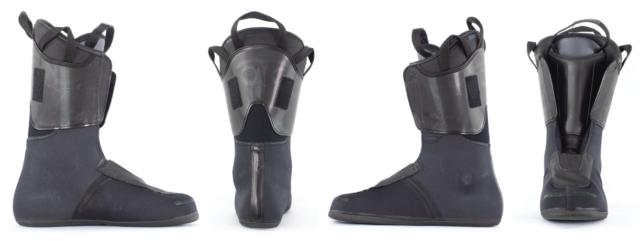
Basically, the Mimic liners are designed to give you the good out-of-the-box fit of a regular, 3D-shaped stock liner but with added customization options usually only found in aftermarket foam liners like Intuition or foam-injected liners. The Mimic material is used in the ankle, heel, and tongue areas and, unlike most heat-moldable foams, the Mimic material can be re-heated, re-molded, and will re-harden many times without deteriorating or packing out. Matt says that people should be able to re-mold the Mimic liners around 4-6 times before the non-Mimic materials in the liner begin to pack out or deteriorate.
Mimic technology aside, the Hawx Prime XTD 130’s liner is very beefy compared to the much more minimal liners in boots like the Tecnica Zero G Tour Pro and 19/20 Atomic Hawx Ultra XTD 130, and a bit more substantial overall vs. the Intuition liners in the Scarpa Maestrale RS & Maestrale XT.
The liner in the Hawx Prime XTD 130 is nearly identical to the new Mimic liners in the Atomic Hawx Prime 130 and Hawx Ultra 130, but the XTD version features a small “flex zone” near the Achilles for less friction while skinning / walking.
Walk Mechanism
The Hawx Prime XTD boots use the same “Free / Lock” walk mechanism as the Hawx Ultra XTD boots, which we’ve come to affectionately call the “prison shank” walk mechanism since the big, aluminum lever looks like it could do some serious damage in a pinch.
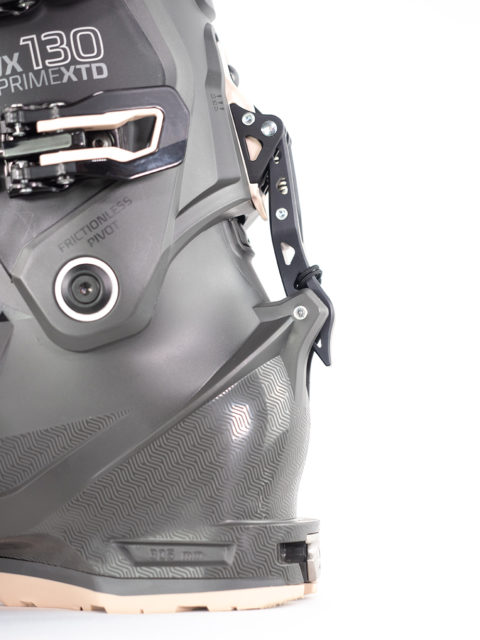
Apart from the silly nickname, we’ve become big fans of this walk mechanism since it’s proven very easy to use, we haven’t had any issues with it accidentally releasing into walk mode, it is not super prone to icing, it feels solid in ski mode, and its external placement makes it easy to service in the event of anything breaking.
Same as the Hawx Ultra XTD boots, the Hawx Prime XTD boots offer a reported 54° of range of motion when in walk mode, which is pretty large for this class of touring boots, but neither exceptionally large nor exceptionally small.
Adjustable Forward Lean
One update for the “Free / Lock 4.0” vs. the previous versions of the walk mechanism is the ability to adjust the forward lean without needing to purchase any “flip chips” from a dealer.
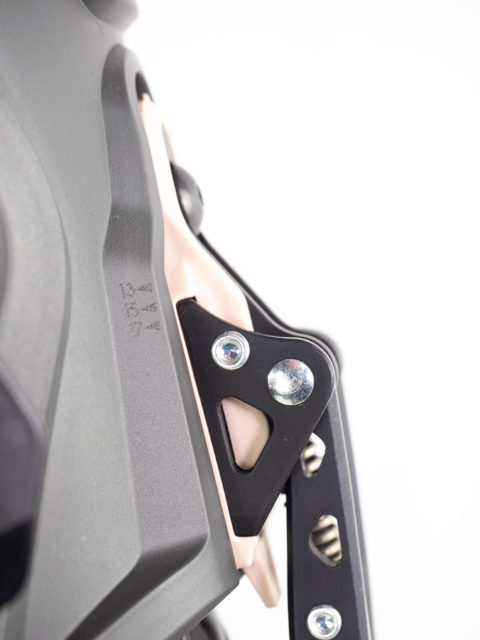
The 20/21 Hawx Prime XTD and Hawx Ultra XTD boots come standard with the 15° forward lean setting, but by loosening the Allen bolt and sliding the walk mechanism up or down, you can change that forward lean to 13° or 17°.
Buckles
The Hawx Prime XTD boots use buckles that are basically identical to those on the 19/20 and 20/21 Hawx Ultra XTD boots. They’re all micro-adjustable and the two upper buckles have sliders on them that let the buckles open much wider than traditional buckles. As a result, you can leave the upper latches on the ladders but leave the buckles fully loosened and still get plenty of range of motion, which can make for quicker transitions and fewer buckles flapping around while you’re walking. I love this feature on the Hawx Ultra XTD boots, so I’m glad to see it on the Primes.
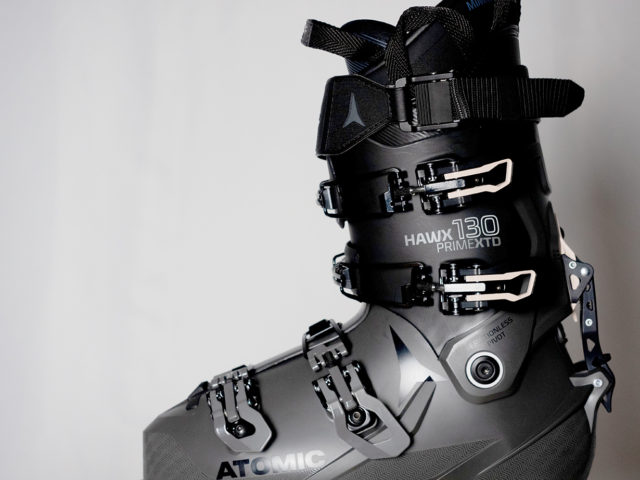
Power Strap
The Hawx Prime XTD 130 features a 50mm-wide power strap with a cam-style closure. The power strap itself is quite thin but it still does a good job of distributing pressure across the upper shell and liner. While the Hawx Prime XTD 130 gets a cam-style strap, the rest of the Hawx Prime XTD boots feature velcro power straps.
Soles
All of Atomic’s Hawx Prime XTD and Hawx Ultra XTD boots feature GripWalk soles. This means they’ll work in a wider range of bindings than boots with full-rubber touring soles like the Tecnica Zero G and Scarpa Maestrale, but it comes at the cost of some grip and overall performance while scrambling on rocks and other firm surfaces.
Fit
First and foremost — please go to a bootfitter to see what boot will work best for you. Fit is the most important thing with ski boots, and is where you’ll want to start. With that said, here’s how the Hawx Prime XTD 130 fits my feet.
For reference, I have pretty average-volume feet, but I have large lateral splats which mean my midfoot widens when I am standing / skiing, and I often get pain on the outside of my forefoot and midfoot when running, skiing, skinning, etc. I have a low instep and an average to low arch. My feet tend to work best with boots that offer ample room in the midfoot and have lower insteps (e.g., the Salomon QST Pro 130 and Nordica Strider 120). Since my toes taper significantly (i.e., my pinkie toe is much shorter than my big toe), I’ve never needed a 6th toe punch in any boots.
Overall, I got a very good fit out of the box with the Hawx Prime XTD 130. My ankle felt secure, I didn’t feel lots of pressure on my midfoot, and I didn’t feel like I had way too much room over my low instep. I.e., the Hawx Prime XTD 130 seemed to work well and didn’t instantly create the usual fit issues I get with most boots.
Since this fit felt good right away, I haven’t yet heat molded the Hawx Prime XTD 130, but I will be at some point since there are some areas that could fit better. Specifically, I am still getting a bit of pain in my midfoot while skiing in the boot for more than about one hour, and I’ve also initially got some blisters on the outside of my pinky toe and the inside of my heel while skinning in the boot. But given that I usually have way worse pain in most other boots, I’m very optimistic about how the Hawx Prime XTD will work for my feet after I’m able to heat-mold it (COVID-19 happened to shut down all the local bootfitters when I got the boots, and most have since switched to their summer operations).
Compared to the Hawx Ultra XTD 130, the Hawx Prime XTD 130 feels notably roomier in the toe box, midfoot and instep. I can barely use the Hawx Ultra XTD without extreme pain in my midfoot and toes, and the Hawx Prime XTD is much more accommodating to my feet in those areas.
Compared to the Tecnica Zero G Tour Pro, the Hawx Prime XTD 130 feels a bit more spacious around my midfoot (less noticeable than with the Ultra XTD), but actually a bit more secure around the ankle pocket. We’ve put a lot of days in the Zero G so this may just be its liner packing out, but I have less heel lift / ankle movement while touring in the Hawx Prime XTD 130.
Compared to the Salomon S/Pro 130 (and the new Shift 130 boot, which shares the same last), the Hawx Prime XTD feels a bit higher-volume in the ankle and instep and roomier in the midfoot.
Overall, the fit of the Hawx Prime XTD doesn’t feel super far off from the Dalbello Lupo Pro HD, though the Lupo has more room over the instep and its ankle pocket feels a bit roomier as well. The midfoot area on these two boots feels similar to me; skiing them for a few hours leaves me with some pain in that area but it doesn’t feel drastically different between the two.
Bottom Line (For Now)
The Atomic Hawx Prime XTD boots bring everything many people love about their Hawx Ultra XTD boots and offer it to people with higher-volume feet. The Hawx Prime XTD 130 is not the lightest boot in this class, but it’s far from the heaviest and I’m very much looking forward to touring in it for as long as I can this season. Blister Members can check out our Flash Review of the Hawx Prime XTD 130 for our initial on-snow thoughts, then stay tuned for our full review.
FULL REVIEW
Right around when the world was turned upside-down by COVID-19, I started using the new-for-2021 Atomic Hawx Prime XTD 130. As I noted in the First Look above, I was very excited by the prospect of getting the performance of the excellent Hawx Ultra XTD 130, but with a fit that … actually fit my feet.
Since then, I was able to spend a lot of time in the new Hawx Prime XTD 130. I skied it for a few days in the resort when that was an option, and then used it as my primary touring boot for the rest of the spring and summer. This included everything from mellow pow laps, to some booter sessions, to some very long and very Type-2-fun days trying to ski down some far-away lines. And then, since I never really want to let go of ski season, I’ve also taken the boots on my sufferfest summer-ski missions. Between all of those different outings, I used it to ski everything from very lightweight, skinnier skis to fat pow skis to metal-laden alpine skis.
After all that, I’ve come away very impressed by the Hawx Prime XTD 130, and I think that it’s a boot that could work for a lot of people. So let’s dive in:
Uphill Performance — Skinning
With a stated 54° range of motion that feels pretty accurate on the skin track, and a fairly low weight of ~1655 g per boot for a size 26.5, the Hawx Prime XTD 130 works quite well when heading uphill. It’s not best in class in terms of range of motion or weight, but it’s notably better on the uphill when compared to boots in the “50/50” category like the Nordica Strider, Tecnica Cochise, etc.
For ~95% of the touring I’ve done in it so far, the Hawx Prime XTD 130’s range of motion and general skinning characteristics have been totally adequate for me.
The only times where I would’ve preferred a lighter boot with more range of motion were super long days that involved a lot of flat skin tracks, since, on flat skin tracks where I’m prone to taking longer strides, I could feel the top of my ankle / bottom of my shin touching the shell of the Hawx Prime XTD 130 at the very end of my stride. I never noticed this on skin tracks that were even slightly steep, so it wasn’t a big issue for me, but there are a couple of other boots in this class (i.e., ~130 flex, 1300-1700 g) that do walk a bit better than the Hawx Prime XTD 130. The Tecnica Zero G is the one that first comes to mind in that regard.
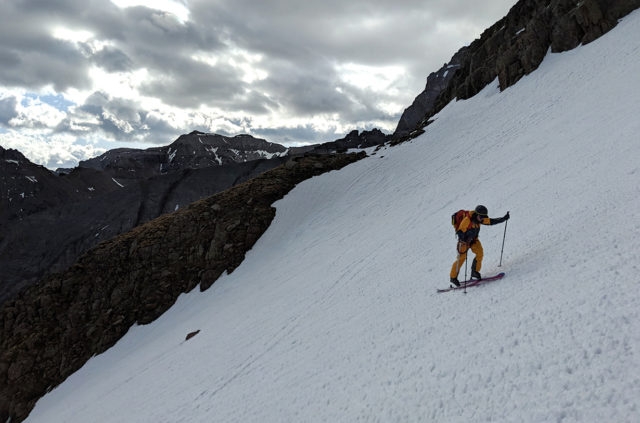
As for the Hawx Prime XTD 130’s weight, I can’t say I noticed it much at all — though I also don’t spend much time in the much lighter, <1300-g touring boots like the Dynafit TLT series, Salomon X-Alp, etc. The Hawx Prime XTD 130 does feel notably heavier than those boots, but as someone who’s spent most of his time touring in boots similar to the Hawx Prime XTD 130, its weight was never really an issue.
The only problem I had with the Hawx Prime XTD 130 on the skin track was some blistering during my first several days in the boot. This went away over time, but I was getting just enough movement around my outer toes and my heel to create some blisters in those areas. Of course, utilizing the boot’s heat-moldable shell and liner would likely fix this, I just haven’t been able to because of the pandemic closing all of the bootfitters around me.
Uphill Performance — Scrambling / Walking
As I’ve noted in previous reviews, I don’t love trying to scramble up or down rocks while wearing ski boots with Grip Walk soles. The hard-plastic portion of Grip Walk soles at the forefoot and under the heel create distinctly low-friction zones — which is what makes them work in the Grip Walk boot / binding interface, but it’s also what makes them less ideal for technical scrambling vs. boots with full-rubber soles.
My position on this mostly stems from one very puckering, steep downclimb I had to do in Grip Walk boots that has apparently scarred me for life, and that was definitely an extreme example that wouldn’t have been easy in most ski boots. And for anything short of hard 4th-class scrambling, the Hawx Prime XTD 130 has been fine.
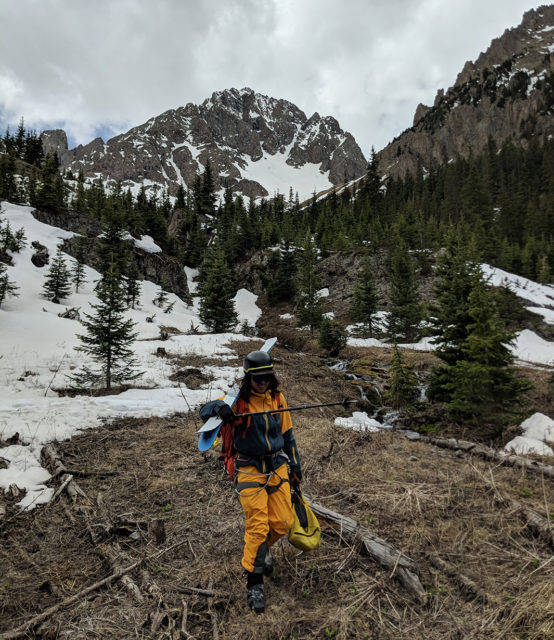
But if you end up doing a lot of more technical scrambling / climbing in your ski boots, this is something to keep in mind, and something I’d say about any boot without a full-rubber outsole.
Crampons / Couloir Climbing
I’ve only used the Hawx Prime XTD 130 with a pair of now-discontinued (and quite heavy) Petzl Dartwin crampons, but nothing about the boot’s sole shape or toe / heel welts make me think you’d have any crampon-compatibility issues with it.
My crampons stayed secure, and while they’re stupidly heavy for most ski mountaineering, I was glad to have them when I accidentally found myself hacking my way up full-on waterfall ice on one of the lines I “skied” in the Hawx Prime XTD 130.
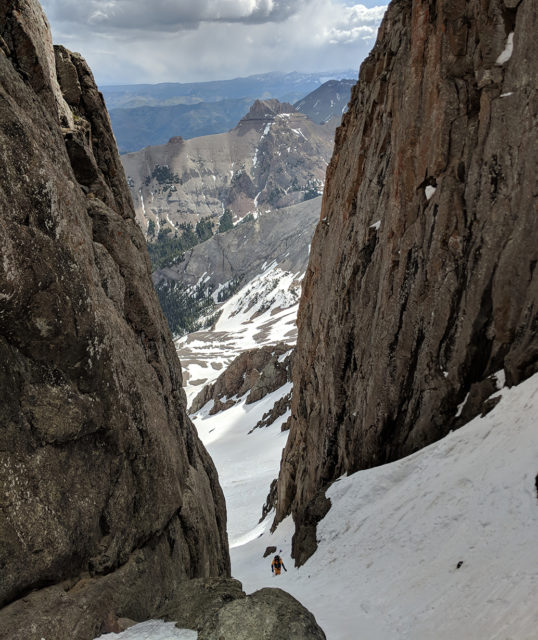
Just as with technical scrambling, if you purposefully climb a lot of vertical ice (not just firm or soft snow) in your ski boots, you’d probably want to check out some of the lighter, shorter-soled boots like the Salomon X-Alp, Arc’teryx Procline, Dynafit TLT series, etc. I find that those shorter soles make for a slightly more precise, sensitive, and secure feeling while ascending ice with crampons. But for any sort of boot packing up snow and crampon-ing up a bit of ice, the Hawx Prime XTD 130 has been fine for me.
Transitions
Transitions have been super straightforward in the Hawx Prime XTD 130. There’s no tongue to take out / put in, I’ve never had any issues with its walk mechanism failing to lock / unlock, and its buckles make the process just a few seconds quicker than some other boots.
As I mentioned above, the Hawx Prime XTD 130’s upper buckles have built-in sliders that let the buckles extend quite far when they’re open. This means that I can leave them latched to the buckle “ladders” while skinning / walking, without restricting the boots range of motion much at all. As a result, I don’t have fully open buckles clacking around while walking, and when it’s time to head downhill, all I have to do is move them to a tighter position and close them.
Same as every other boot I’ve used with a similar-style walk mechanism, the Hawx Prime XTD 130’s walk mechanism has been flawless so far. It’s stayed locked when I wanted it to, it’s stayed unlocked when I wanted it to, and I’ve had zero issues with icing. And if I ever happen to have it ice up in the future, I’m sure it’ll be easy to clear with a few quick whacks of a ski pole (based on my experience with previous boots with similar walk mechanisms).
Downhill Performance — Flex Pattern
Long story short: the Hawx Prime XTD 130 skis very, very well for how well it walks.
In terms of the maximum stiffness you get out of the boot when fully flexed, I’d say it’s quite similar to a 130-flex alpine boot, though a bit softer at the very end of the flex vs. a legit, 130-flex alpine boot. On the other end, the Hawx Prime XTD 130 also feels a bit softer off the top / at the beginning of the flex than legit 130-flex alpine boots.
But these are pretty subtle differences in my experience, and I wouldn’t go as far as to say that the Hawx Prime XTD 130 should have a “120” at the end of its (long) name. More importantly, for me, is the fact that the Hawx Prime XTD 130’s flex pattern is predictable and progressive. It’s easy to initiate / get into the flex, and then it smoothly gets stiffer the deeper / harder I flex the boot.
Especially in unpredictable backcountry conditions and terrain, this sort of predictable flex can be really helpful. E.g., when I’m going in and out of the sun or switching between aspects, and consequently switching between snow densities / surface structures, I don’t want a boot that feels impossible to flex off the top or one that supports me at first but that then promptly, randomly gives out and lets me blow through the flex. The progressive flex of the Hawx Prime XTD 130 lets me feel in control, even when I’m not pushing into it very hard, but it also hasn’t left me suddenly wishing for a stiffer flex when I’m really laying into it.
Now, it’s worth noting that I’m not a big guy at 5’8”, 155 lbs / 173 cm, 70.3 kg and I’ve been pretty content skiing 120-flex and softer “130-flex” alpine boots in the resort. So if you’re a larger individual and / or tend to prefer very stiff boots, you may still want to look at the stiffest options in this category (e.g., Dynafit Hoji Free and Scarpa Maestrale XT). But if you’ve never found yourself thinking “this 130-flex boot is way too soft,” I doubt you’ll have any major complaints about the flex pattern of the Hawx Prime XTD 130.
In terms of lateral support, I have no complaints with the Hawx Prime XTD 130, but I also rarely find myself noticing a lack of lateral support with most ski boots I try. However, I will say that the Hawx Prime XTD 130’s rearward support is quite good, something I will notice, particularly when trying to load up the tails of my skis or, more frequently, when trying to pull myself out of the backseat.
The last thing to note regarding the Hawx Prime XTD 130’s flex pattern is its “rebound” or “energy.” Personally, I find most Grilamid-shell boots like the Hawx Prime XTD 130 feel more energetic / springy / lively compared to most PU-shell boots. To me, the Hawx Prime XTD 130 feels like it snaps back / rebounds more quickly once I lay off it, compared to heavier, PU-shell boots. I don’t really see this as an upside or a downside, just something I have to get used to for a few turns when I’m switching between heavy alpine boots and lighter boots like the Hawx Prime XTD 130.
Downhill Performance — Mimic Liner
I didn’t mention the Hawx Prime XTD 130’s new “Mimic” liner in the Uphill Performance section because I just haven’t really thought about it on the ascent. But on the descent, I definitely notice it, and I definitely like it.
Compared to most boots in this class — especially those that are notably lighter than the Hawx Prime XTD 130 — the new XTD 130’s Mimic liner is a big part of why it is, in fact, heavier. For example, the Tecnica Zero G Tour Pro’s liner is almost half the weight of the Hawx Prime XTD 130’s liner — and it feels like it on the descent.
Compared to most lighter liners, the Hawx Prime XTD 130’s Mimic liner feels like it does a significantly better job of absorbing and muting out all sorts of impacts and vibrations you experience while skiing, particularly on firmer, rougher snow conditions. In this way, it feels much more similar to most liners in alpine boots, whereas a lightweight liner like that in the Zero G Tour Pro feels substantially thinner, less substantial, and just less “plush” when trying to ski fast in crappy snow.
Does that make the Hawx Prime XTD 130 feel exactly like a much heavier, riveted-cuff alpine boot? No. The Hawx Prime XTD 130 still doesn’t do quite as good of a job of damping harsh snow conditions vs. most 1800+ g, PU-shell alpine boots I’ve used. But the Hawx Prime XTD 130 does feel notably better in this regard than most of the lighter options in this class.
The other upside of Atomic’s new Mimic liners is that they can be repeatedly heat-molded to really dial in the fit. Unfortunately, as I noted above, I haven’t yet been able to test this due to all the ski shops needing to close amid the pandemic. But I will definitely be getting these boots molded as soon as I can.
Who’s It For?
From my perspective, I see a few different categories of skiers getting along well with the Hawx Prime XTD 130.
First, if you liked the sound of the Hawx Ultra XTD 130 but it was too low-volume for your feet, go try on the Hawx Prime XTD 130. Or, if your feet fit really well in the regular Hawx Prime 130 and you want something you can use for touring, that’s the Hawx Prime XTD 130.
Aside from those already familiar with the Atomic Hawx series, I think the Hawx Prime XTD 130 would make a great do-everything touring boot for those who walk up hills with their skis for the purpose of skiing fairly aggressively on the way down.
If you do a ton of really long days or just prioritize the up a bit more than the down, I’d look to the numerous lighter, higher-range-of-motion boots on the market. There are a few boots that are similarly stiff but walk better than the Hawx Prime XTD 130, and it definitely does not match the hiking-boot-like ascending capabilities of the <1300-g boots. But if you want a touring boot that walks quite well, has a nice, progressive flex pattern, and that feels more comfortable or “plush” in rough snow than most lighter options, the Hawx Prime XTD 130 warrants strong consideration. Personally, I’d be content to use the Hawx Prime XTD 130 for literally all of my human-powered skiing.
While I think the Hawx Prime XTD 130 makes the most sense as a dedicated touring boot, I think it’ll also work well for people who want a boot that they’ll use for touring and some lift-accessed skiing. Everyone’s priorities differ, but for me, I see this as a roughly “70/30” boot, where 70% of the time you’ll be using it for human-powered ski touring and 30% of the time you’ll be using it in the resort. I think the more substantial liner of the Hawx Prime XTD 130 (and 20/21 Hawx Ultra XTD 130) make it a bit more appealing for aggressive inbounds laps than the lighter competition, though if you spend most of your time skiing inbounds, I’d still recommend the slightly heavier “50/50” or “crossover” boots like the Nordica Strider, Tecnica Cochise, Dalbello Lupo Pro HD, etc.
And just in case we haven’t banged this drum enough, all of the above recommendations are made with the assumption that the Hawx Prime XTD 130 actually fits your feet.
Bottom Line
Backcountry skiers are pretty spoiled today, when you look at what the gear options were just a few years ago. There are now very lightweight skis that are not terrifying to ski; there are now touring bindings that truly match the performance of alpine bindings; and there are now touring boots that come very close to skiing downhill like dedicated alpine boots.
The Atomic Hawx Prime XTD 130 is a great example of how far ski-touring boots have come. It offers enough range of motion and comes in at a low enough weight for most days on the skin track, while offering a strong, yet progressive flex pattern on the descent. On top of that, its shell and liner are both customizable in terms of fit, and its new liner makes it stand out from the slightly lighter competition when it comes to dulling the harsh impacts of skiing fast on rough snow.
All in all, the Hawx Prime XTD 130 is an impressive touring boot, and if you’ve found yourself struggling to fit into the numerous, lower-volume, 130-flex AT boots in this category, I’d highly recommend going to your local bootfitter and seeing if the Hawx Prime XTD 130 fits your feet.
Deep Dive Comparisons
Become a Blister Member or Deep Dive subscriber to check out our 130-flex Touring Boot Deep Dive where we compare several 130-flex alpine touring boots, including the Atomic Hawx Prime XTD 130, Atomic Hawx Ultra XTD 130, Dalbello Lupo Pro HD, Tecnica Zero G Tour Pro, Dynafit Hoji Free, Scarpa Maestrale XT, Lange XT3 130, Lange XT Free 130, K2 Mindbender 130, Fischer Ranger Free 130, & Dalbello Lupo Factory.

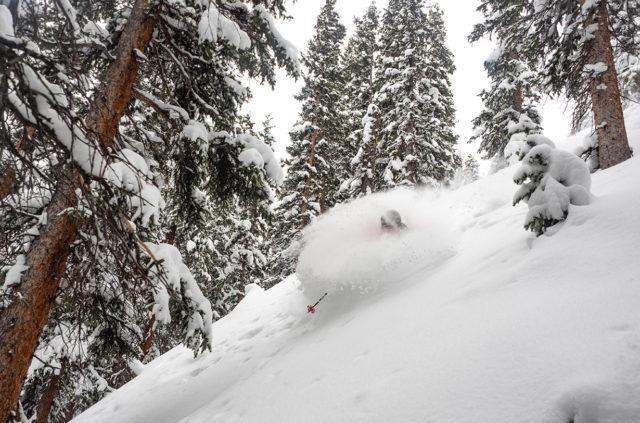
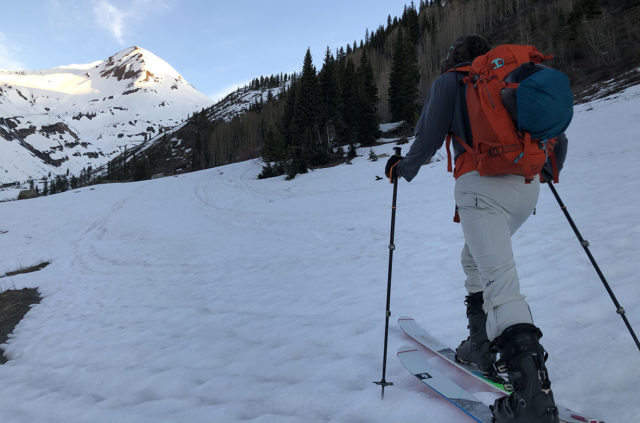
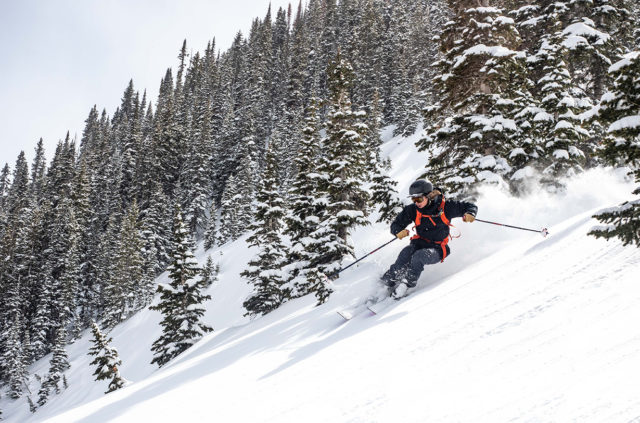
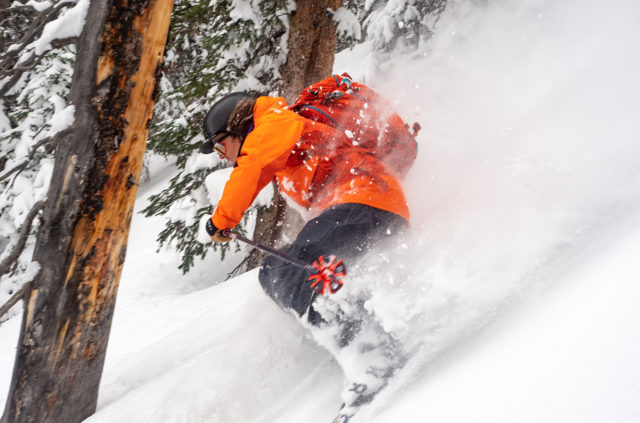
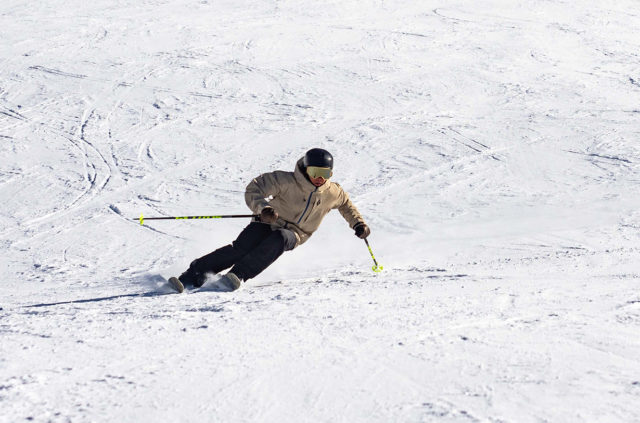
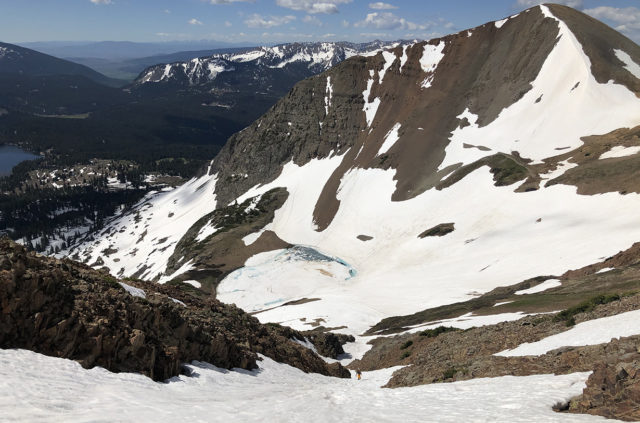
PLEASE do a review of the 20/21 women’s Atomic prime and ultra XTD 115 boots as well….
Sorry we missed this note — we weren’t able to get a pair of the 20/21 women’s Prime or XTD boots last season, but one of our female reviewers should at least be reviewing the new Ultra XTD 115 this coming season.
Hey Luke, what do you mean when you say: “As someone who cannot cram their feet into the Hawx Ultra XTD without some serious pain”
When exactly does it hurt, in the process of putting your foot in the boot or while wearing the boot? I tried the Ultra XTD two years ago and remember that putting it on was a troublesome, I had the idea that I was gonna break my foot. Once on my feet they were wonderful.
I was referring more to the fact that the Ultra XTD doesn’t fit my feet well. I can get it on (I have a low instep so getting the boots on usually isn’t the issue), but my toes feel very crammed and I get a ton of pain in the midfoot area.
I’m really impressed by Atomic’s choice to put a 400 g liner in this boot. I think that it shows a willingness to put real-world usability above the all-important weight spec, and it’s a nice change from the trend of some recent 130-flex touring boots with near-unusable 200 g liners (ahem, Tecnica).
Let’s hope that more makers follow suit.
In the first year of development for this boot, we went back and forth on this topic a lot. Weight targets are easy to win on paper, but they come at the sacrifice of three super crucial aspects: Fit, Comfort, and Performance. We could have made another 1400g boot, but it would have definitely suffered in all three of those areas. Ultimately, we just said screw it. Weight targets are nice, but boots are made to fit and ski well, and this is why the Prime XTD and the Ultra XTD got liners that can handle the rigors of being a resort daily-driver.
Cheers
Matt
I think that current 200-250 g liners are marginal for the kind of touring people do in this sort of boot, never mind daily-driving in a resort.
I have Zero-G Pro Tours and I only use them in the backcountry, as I have ~1800 g and ~2500 g boots to choose from for resort use. Even so I ended up putting Intuition Pro Tours in the Zero-Gs because the stock ones just didn’t work for aggressive downhill riding. Most of the bootfitters I’ve talked with who use that boot (and there are a significant number) have done the same.
I’m think that ultralight liners work in less substantial “uphill oriented” boots like TLTs or Backlands, but the combination of a 130-flex 4-buckle overlap shell and a nonexistent liner seems problematic to me (unless you’re racing at a high level and that shell is a well-fitted plug, but neither applies here).
Matt and Patrick,
Totally agree. Liners need to provide performance, comfort, warmth and durability. In this type of boots, that needs some meat. Partly this can be overcome by using higher end materials (just like switching to grillamid from PU), but mostly it just is going to be some extra mass.
If you own a boot like this and want to do a fast and light tour, get some aftermarket, super light liners.
Do you know if you will be able to purchase the new Mimic liner separately and if it will work in this years Hawx Ultra XTD 130?
Yep, you’ll be able to purchase the Mimic liners themselves via an Atomic dealer, and the shell of the Ultra XTD isn’t changing, so it’ll be a perfect fit if you have a previous-year shell.
Is there more volume in the ankle as well? I have the 19/20 Hawx Ultra XTDs, and even with heating molding and some punching, I still have some pain in my 6th toe and the inside of my ankles.
Hi Steve, Yes- the Prime XTD last has a slightly wider heel & ankle and a taller instep to go along with the wider forefoot. Even though the heel/ankle is slightly wider than the one found in the Ultra XTD, it’s definitely not a loose or sloppy fit.
I just got in the current Ultra XTD and the G Zero Tour Pro. I spent some time in both at home yesterday. Out of the box, the Ultra XTD felt like it had slightly more volume almost everywhere (except perhaps the heel). The Ultra XTD also felt like a softer flex. I have a very low volume foot – ski the Atomic Redster World Cup 130 and Dobermann before that. So I decided to try the G Zero in lieu of the Ulltra XTD. After a couple more hours in the G Zero at home I skinned up Aspen Highlands today. The boot was great – both up and down. I was coming off a Mastrale RS that was too roomy and too soft on the downhill. What an improvement. I was really looking for improvement on the downhill and, while I will always prefer a stiff alpine boot, the G Zero did remarkably well for such a light boot. I thought the uphill performance was very good as well. I ski the Corvus Freebird with Dynafit tech bindings for a/t. I would like a bit more forward lean (I think I can adjust) and found that I had to balance a bit on the ski and not get back in the variable terrain. But overall, I really like the G Zero Tour Pro for a/t. Based on what I see, Atomic’s 2021 boot may possibly be better downhill, but weight is a potential issue for me.
IMO the Zero-G Pro Tour is a terrific boot (I have a pair). I also think that it’s selling a lot of liners for Intuition, though.
Even with an Intuition Pro Tour liner with stiff tongue and Sidas custom footbed that boot only weighs ~1450 g.
Since you mentioned forward lean: Did you try flipping the piece in the walk mode assembly that converts it from “12 degrees” to “13”?
I planned on looking at that before I go out next time. Thanks.
Hi Luke, how would you compare the 2020-2021 Atomic Hawx Prime XTD 130 to the Dynafit Hoji Free 130 in terms of fit, last and stiffness? Thank you
I have last year’s Ultra XTD 130. I love them except for getting them on which is really difficult. I would also like a more customized fit as i have very thin ankles and heels to go with my low-instep flat feet. Will I be able to get the new liners separately for my boots? I do mostly resort skiing with the occasional uphill day.
Yep, you’ll be able to get the Mimic liners through an Atomic dealer. FWIW, Atomic’s Matt Manser said that while the Mimic liners won’t expand when molded, but he did say (and we can confirm) that the Mimic liner in the 20/21 model is significantly thicker than the previous liner. As far as whether or not it’d take up all the needed space for you, we’d differ to a bootfitter as they’d have a much better idea of that.
I own the first gen Atomic XTD 130 with the orange, light weight touring liner. It tours very well, the liner allows virtually friction free movement, and I think is about 200 g’s lighter than the new Mimic liner. It definitely gives up some snugness, comfort, and control on the downhill. If I am walking uphill, I don’t mind it at all, since I am not doing lots of runs in a day. When I use the boots periodically for resort skiing, I do notice the light, thin liner. I am planning on getting a second liner, the new Mimic version, for resort days. I expect those to be just what the doctor ordered. I was told by Atomic that you can get the thin touring liner or the new Mimic liner with the boots. I assume the Mimic is standard and you order the touring liner, not sure? I am doing the opposite since I use the boot for Ski Race coaching and the walk mode and rubber soles are much nicer when standing around on boilerplate courses compared to my race boots.
Yep, that’s correct — the 20/21 Hawx Ultra XTD 130 comes standard with the burlier Mimic liner, but you can get the lighter liner separately, as well as ordering just the Mimic liner on its own.
Hi Luke,
In the text you sortie, it sounds as if the tech fittings are in the removable soles. But in the pictures it looks as if the tech fittings are in the fixed part of the sole.
Could you clarify this?
Ah, yeah that wasn’t worded super well — the tech fittings are fixed in the main shell; the replaceable part of the sole is pretty much just the tread.
Hi, I also own 20/21 Hawx Ultra XTD 130 and find the liner too thin when doing lift-assisted runs. I was thinking of buying a pair of red liners from Ultra XTD 120. Can you tell how the new Mimic liner compare, which one is more plush?
Hi Palo,
Are you sure you have the 20/21 Hawx Ultra XTD 130? The 20/21 version is all black with some sand-colored accents and has the new Mimic Platinum liner in it, which is built just like the liners found in the regular Hawx Ultra range (= not a light weight, loose-fitting liner). It fits and skis just like a regular Hawx Ultra.
Just to make it easier for everyone, let’s do it this way:
-19/20 Hawx Ultra XTD 130 (grey/green color way) has a beefed up touring-oriented liner. It is better than the older, orange liner but it’s still on the lighter side of things. If you are 100% skiing in-bounds/using lifts, then it’s probably not the idea liner for you.
-19/20 Hawx Ultra XTD 120 (dark blue/red color way) has liner that is built just like a normal Hawx Ultra, but with a flex zone that allows for touring/walking. It’s fits & skis just like a normal Hawx Ultra liner (= fine for 100% in-bounds use), but it does not have any Mimic material in it.
-20/21 Hawx Ultra XTD 130 (black/sand) & 120 (black/red)- these boots come with Mimic Platinum liners that are built just like a normal Hawx Ultra, but with flex zones that allow for touring walking (= find for 100% in-bounds use). This is the same construction/build that is reviewed above. The lighter weight liner from the 19/20 Hawx Ultra XTD 130 is available only as an aftermarket option.
Hope that makes more sense!
Hi onenerdykid,
You are right, I have the grey/green version 19/20. The liners are good for touring a fluffy powder but super-painful for hard snow conditions. So I decided to buy a second pair of liner for only short walks and/or more lift-assisted rounds with not so smooth snow. I wanted to hear what’s better option, if new mimic liner from prime or dark blue/red from Ultra XTD 120. Thanks, Palo
Hi Palo,
A new Mimic liner (for either Hawx Ultra XTD or Prime XTD) would be just as damp, cushion-y, supportive, and as powerful as the liner from the blue/red Ultra XTD 120. They are built the same way.
The only difference is the Mimic technology in the new liner. That material is not found in the 19/20 blue/red Ultra XTD 120 liner.
Great write up that also mentions comparable boots. I’m a bigger skier that falls into the larger 200lb class. Based on other Blister reviews, a boot that sounds like it should be comparable but not mentioned is the Head Kore 1. How does the Hawx Prime XTD 130 compare to the Had Kore 1?
Long story short: the Kore 1 is notably softer, particularly in the middle of its flex pattern, and it also offers slightly less forward range of motion. The Kore 1’s flex pattern feels very linear and quite soft until you get super deep into its flex, at which point a plastic bulge molded into its shell prevents flexing through the boot. I find the Prime XTD’s much more progressive flex pattern a lot more intuitive and predictable, and that plastic “stop” on the Kore 1 also somewhat impedes its uphill range of motion when taking longer strides.
Appreciate the feedback. I’ve tried on the Kore 1 and agree about the flex pattern and their comparatively less range of motion. In pure a sense, how would the the stiffness rank for the Prime XTD’s, Hoji Free’s and the Maestrale XT’s?
We got into more detail in our Deep Dive of AT Boots: https://blisterreview.com/deep-dive/deep-dive-130-flex-touring-boots
But long story short, the Hoji Free and Maestrale XT are the two stiffest boots in the category (Hoji Free being the stiffest). Comparing them to the Prime XTD 130 is definitely not like comparing a 150-flex vs. 130-flex, but those looking for the stiffest AT boots that still walk really well and are quite light should try on those 2 boots. The Prime XTD 130 will be plenty stiff for most people who like a 130-flex alpine boot, but I’d say it’s subtly softer than some of the best 130-flex alpine boots (e.g., Lange RX, Head Raptor).
So basically, if I am understanding this correctly, only the stiffest boots of the men’s and women’s range ie 130/115 flex, are built with grilamid and mimic liners. The 120/100 boots are built from true flex pu and don’t have mimic liner and are thus heavier, with a “less good” touring liner. This seems a bit bizarre to me, because isn’t flex choice based more on your weight and skiing style? Ie I am a 150lb, 5’9” woman, whose resort boot is 110 flex. I don’t need a 130 flex boots for skiing backcountry powder. I also like the men’s boots better, because of the higher cuff on my shin. But unless I want a super stiff boot, it seems I’m left with the second tier option for backcountry, ie the heavier 120 flex with non – mimic liner. Which is a bit irritating to me, because the atomic boots fit my feet perfectly when compared to other boots available. Why is there an assumption that only people who want the stiffest boots, also want lightness? Or is a function of grilamid vs pu plastics? Ie grilamid shell at a certain thickness = x weight and a certain flex, which is stiff. Making it thinner to make lower flex would make materials too thin? Or?
Just to clarify, are you looking at the Hawx Ultra XTD or Hawx Prime XTD lines? The new, wider Prime line doesn’t have a men’s 100 flex, but the existing, narrower Ultra line does. I ask because the Prime 120 v. 130 are substantially different weights (over 6oz per boot), but the Ultra 120 vs. 130 are quite close (about 1.5oz per boot). The Ultra 120 also comes with the Mimic Platinum liner while the Prime 120 liner is their 3D Gold.
From there, I’d definitely get your feet in them to test the flex before writing off the 130s. Flex pretty meaningless outside each individual product line. I ski a Tecnica Mach 1 105 inbounds, but I was torn between the Tecnica Zero G 115 and 130 for a touring boot. Ultimately settled on the 115, but it’s noticeably softer than my inbound boots. Likewise, I’ve heard similar feedback that the 130 & 115 flex Ultra XTDs ski softer than the Ultra S alpine boots with the same flex number. I’d give them a shot and work with a fitter to determine if the 120 and/or 130 is something you can flex.
In terms of your question about why boots seem to either be stiff/light or heavier/soft, it’s actually pretty common. The women’s Hoji PU/Pro and Zero G Tour/Scout. Cost is a big consideration. Most of the women I know who have landed in the Hawx Ultra XTD 95 have the skill and size to handle the 115, but preferred the 95 since they were buying their full setup, avy gear, and education all at the same time. The material differences keep the cost down while the softer flex keeps the weight in check. Also, from a line planning perspective, going with Grilamid on the 95 & 100 models would make them light enough to start blurring the lines between them and the 95/100 flex Backland Pros.
Hm, interesting. Thanks for the reply. I was talking about the ultra xtd vs the prime xtd. Unfortunately in my area, there is now a boot shortage for touring boots. I can get the correct size in ultra 130 xtd, last year’s ultra xtd 110 or the new prime 120 xtd… So I will have to see what fits best. I find it so difficult to decide what boot will work best for both skiing and skinning, when standing in a store. High stakes decisions when the boots cost so much!
The regular Atomic XTD 130 is a bit too snug for my instep and has marginal width in the toe box. The Prime XTD fits my foot pretty well. Can anyone comment on how the Tecnica Zero g boot compares in fit?
Hi onenerdykid,
I have the 1st year (17/18) Hawx Ultra XTD 120s with the orange liners. I think I’ve got less than about 30 days on them and the liners are packed out and I’m dealing with bad blistering at the heels. I’m considering replacing the liners with Intuition but was curious what recommendations you might have before I go that route? Aside from this issue that have been really great boots!
See my comment below. I’m trying a similar approach for a different situation.
Hi Jimmiski, sorry for the delayed response. If you are still looking for a new liner, I would suggest adding the Mimic Platinum Ultra XTD liner to your short list. This is new update for the 20/21 season and it will mold better and ski better than an Intuition liner, with about the same weight as your current liner. An Intuition will be lighter but won’t offer the same level of customization or skiing performance.
I’ve had the same rubbing issue at the top of my ankle/bottom of my shin. I love everything else about the boots, but that friction is annoying. I swapped some beefier liners into the shell to see if that made a difference and it did. I’m now planning to replace the liners with some intuition pro tours, and heat mold the liners and shell to reduce friction in that location. I’m optimistic that will take care of the problem and maybe even shave a few grams. But overall these boots are amazing – great on the up and absolute rippers on the down.
Thanks for this incredibly in depth review. I am torn between the Ultra and the Prime. The dilemma comes from a Mortons Neuroma I have on my right foot. Leaves my right foot burning around 2pm every day I ski. I had both feet measured and my left foot is 100mm and right comes in at 105mm (Bunion w/ neuroma). I like the snug fit of the Ultra, especially on my left foot, but am concerned about the tight fit aggravating my Neuroma. I would need to get the right toe box pushed out to stop the squeezing.
Herein lies my question: will the ultra toe box stretch out from 98-105? Or at that width should I be going with the prime at 100mm?
That’s definitely a tough call. I suspect that the Ultra would work alright after molding and some additional punching / stretching, but I’m not sure. I’m more confident you could get a comfortable fit in the Prime, but I’m guessing that might leave you with a touch more room around your ankle than you want. But overall, I think I’d lean toward the Prime.
Colby – PM if you want to extend this chat. I have been working around a similar problem for the last 10 years. Always good to compare notes. I hear you on the need for a tight heal grip and wide toe box — and those afternoon burning pains…
I’ve had a few first hours on these now. Absolutely love them.
Coming from Lupo AX120 these fit like a sock. Not sure if I have to do any modifications — the Mimic liner does what it promises quite well. Was actually quite amazing to kind of forget wearing a new boot just after a few runs. Getting the boots on and off is a bit of work but that probably gets easier over time.
The “floor feel” is really good for me personally. I skied Black Crows Atris 108mm on a fresh, icy artificial resort snow. Compared to Lupo, these feel lighter and it took a few runs to get used to them. After that, hot damn. Personally I was after a steeper forward lean and these boots do the trick. Quite looking forward taking these into steep snow and uphill next month.
As this is a ‘heavier’ boot on the spectrum of AT boots these days, would it be “too much boot” for today’s lightweight tech bindings? Or would it be more appropriately paired with a burlier tech binding?
Hi onenerdykid,
I am looking to purchase a new pair of boots to replace a pair of Scarpa Freedom SL. The two choices that I have narrowed down to are the Scarpa Maestrale RS and the Atomic Hawx 130(not sure if Ultra or Prime will work).
Any suggestions for those of us who are used to being on a rubber touring sole? As Luke mentioned, I too am leery to rely on WTR when having to do rock scrambling. I really think that Atomic has nailed the tech and knocked it out of the park.
Just wish we had a option to buy one set of soles vs the other.
Thanks,
Mark
Meant to say leery of using GripWalk soles for rock scrambling and would like the option to choose the type of soles for this boot.
Open to suggestions, look forward to people’s thoughts on this.
Thanks,
Mark
Good morning, great write up. I have a slightly older model (2020, black and orange, prior to Mimic liner) that I’ve been skiing for two seasons plus. I dig the boots, they ski well and don’t hurt my feet. Unfortunately the screw that holds the tech fitting on the boot heal has broken twice. Atomic was able to extract the broken screw the first time but has not been able to this time.
Is anyone else having durability issues with that boot? I’m inclined to buy another pair as they ski well and don’t hurt but am not crazy about replacing boots after ~ 50 days dedicated touring or buying gear that has not been durable.
Cheers,
Jim
Just purchased a pair of Ultra XTD and will get out for a four day resort trip this week to try them out.
I am surprised at the camlock power strap. It really isn’t very easy to use with gloves on. My gut tells me I’ll be swapping the straps out for a velcro version but am interested on feedback from others.
Thanks in advance
I have Prime 130’s I have been using them for everything but first multi day tour I got a serious blister on inside below ankle from skinning with buckles undone. I looked at possibility of adding laces but instead bought Intuition Tour wrap liners which have a drawstring system, weight of my 265 boots with Intuitions and footbeds is 3040g vs 3400g with Mimics and footbeds. Perhaps the Intuitions are not as plush but with the two layers over the shin area they feel great and there is a little more room around the toes which I like. Another reason I went for wrap liners is a nasty bone spur on top of my left foot which tongue liners aggravate. Overall pretty happy with the setup now.
However lately I have been thinking of buying another boot, maybe more touring oriented, looking around the new Scott Cosmos Pro looks and reads well at 1400 per boot with an ultralon liner with Boa laceup system, it is a “hybrid cabrio”. Has anybody out there tried this boot? I would love some feedback on these. My reading suggests a few things, firstly the 27.5 is the same length as a 26.5 in most other brands. Any other comments would be most welcome.
Hi, guys!
The official Atomic site says about the weight:
Weight (g) / Boot (Size) : 1,840 / 26-26.5
It is 200 grams heavier, than your measurements…
Do you think something is changed in 22/23 model?
The liner.
The lower part has been reinforced a bit I think. The liner already changed in this 20-21 model. Also, the shell materials have changed progressively over the model year, this 20-21 boot stated material is “Grilamid” (Polyamide). The 21-22 boot, if I recall correctly, was polyurethane/Grilamid, and 22-23 boot is all polyurethane.
UPDATE: After few days testing: these boots are best AT boots on downhill side and big disappointment for touring. The just don’t have enough ROM. 54 degrees it theoretical, impossible to have more, than 20 degrees, mostly forward… do not buy for touring, except for occasional transitions to better lines, near the lifts…
How did you try to ski the boot? If I had to guess, the stated ROM is achieved by setting the upper bucles to the loose positions and pushing the buckle levers to the forward position.